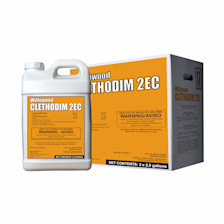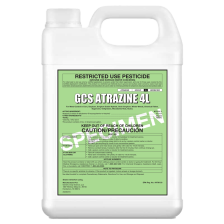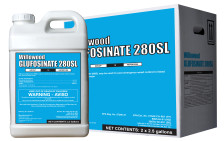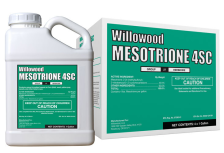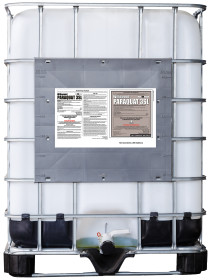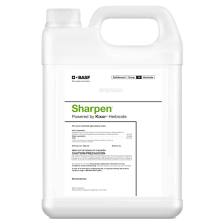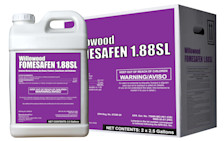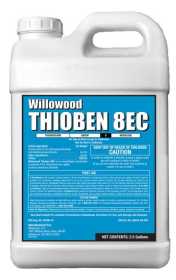Herbicide Mode of Action Groups 101
The terms “mode of action” and “site of action” are often used interchangeably when referring to herbicide classifications, but they’re not exactly the same. Understanding the difference between a herbicide’s mode of action and its site of action can help you build a successful weed control program while also managing herbicide resistance.
In this post, we will explore:
What’s the Difference Between Site of Action and Mode of Action?
Think of the site of action as the “where” and the mode of action as the “how” herbicides work. Herbicides are classified into site of action groups based on the particular enzyme or metabolic process they disrupt in a weed.
Multiple site-of-action herbicide groups may fall into broader mode-of-action groups, which describe how the herbicides disrupt weed growth and development. For example, Group 2 ALS inhibitors and Group 9 EPSP synthase inhibitors disrupt different weed enzymes, but they fall under the same mode of action group, amino acid synthesis inhibitors.
Why Is Mode of Action Important?
Understanding a herbicide’s mode of action can help you choose the most effective product for managing a weed based on its unique biology and life cycle. It can also help diagnose crop injuries following a herbicide application. However, understanding the herbicide mode of action is most important for managing herbicide resistance and stewarding effective chemistries so they have a longer lifespan.
When your weed management program includes herbicides with multiple modes of action, you can:
Mitigate risk
Achieve complete weed control more consistently
Delay weed resistance in your fields
Mode of Action and Herbicide Resistance
You may have heard that you should rotate herbicide modes of action to reduce the risk of developing herbicide-resistant weed populations. The science behind herbicide resistance can be complex, but here’s a simplified explanation.
Imagine you have a field that contains waterhemp. Basic biology tells us that some of the waterhemp weeds in your field have innate genetic tolerance to Herbicide A. When you spray Herbicide A, most of the waterhemp plants will die, but those with natural tolerance to the herbicide will not. In turn, those more tolerant weeds will reproduce and spread their genes, building up the population of resistant weeds. Herbicide A eventually becomes ineffective on a majority of the weed population because it’s been relied upon too heavily for control.
Now, consider the same field where you use multiple herbicide modes of action to manage weeds. You’ve added Herbicide B and Herbicide C to your tank mix. Those waterhemp weeds with natural resistance to Herbicide A’s mode of action are controlled using the alternative modes of action from Herbicides B and C. The result is more consistent weed control, reducing the ability of herbicide-tolerant weeds to reproduce.
For more information on herbicide groups and a classification chart, click here.
9 Herbicide Modes of Action Groups
Here are nine common herbicide modes of action groups used in agricultural production. Use the information below to help build a season-long weed management program that includes herbicides with multiple modes of action.
1. Lipid Synthesis Inhibitors
What Are Lipid Synthesis Inhibitors?
There is currently only one lipid synthesis inhibitor herbicide group, the ACCase inhibitors, which includes three chemical families, commonly referred to as:
FOPs
DIMs
DENs
Active ingredients with this mode of action include:
Clethodim
Fenoxaprop
Pinoxaden
How Do Lipid Synthesis Inhibitors Work?
ACCase inhibitors disrupt the ACCase enzyme in plants, leading to cell death due to membrane dysfunction.
How Are Lipid Synthesis Inhibitors Used?
Lipid synthesis inhibitors, also known as graminicides, are used exclusively for grass control. These herbicides are applied primarily to broadleaf crops or fallow fields for selective, postemergence control of annual and perennial grass weeds, but some products may be labeled for use in grass crops to control specific grass weeds.
Site of Action Groups
ACCase inhibitors (Group 1)
Lipid Synthesis Inhibitor Herbicides Examples
2. Amino Acid Synthesis Inhibitors
What Are Amino Acid Synthesis Inhibitors?
Amino acid synthesis inhibitor herbicides include:
ALS inhibitors
EPSP synthase inhibitors
While both herbicide classes disrupt amino acid synthesis, they do it in completely different ways; thus, they may be considered different modes of action for resistance management purposes.
Common active ingredients with this mode of action include:
Glyphosate
Thifensulfuron
Imazethapyr
How Do Amino Acid Synthesis Inhibitors Work?
Amino acid synthesis inhibitors disrupt the production of critical amino acids required for proper plant growth and development.
How Are Amino Acid Synthesis Inhibitors Used?
Amino acid synthesis inhibitors are some of the most widely used herbicides in agricultural production. They are active on annual and perennial broadleaf and grass weeds and offer varying degrees of selectivity. However, due to their wide use, more weeds are becoming tolerant or resistant to amino acid synthesis inhibitor herbicides.
Site of Action Groups
ALS inhibitors (Group 2)
Has more active ingredients than any other herbicide mode of action
Comprised of five chemical families, including imidazolinones (IMIs) and sulfonylureas (SUs)
May control annual and perennial broadleaf or grass weeds; varying selectivity based on the herbicide
Can be soil or foliar applied
More than 50 different weed species in the United States are resistant to Group 2 herbicides
EPSP synthase inhibitor (Group 9)
Glyphosate is the only active ingredient in this site of action group
Nonselective, contact, postemergence herbicide for grass and broadleaf weed control
Offers excellent control of perennial weeds and is also effective on annual weeds
Can be applied to genetically modified glyphosate-resistant crops, including corn, soybean, cotton, and canola
Weed injury symptoms are slow to develop; complete weed kill can take up to 14 days
More than 15 weed species in the United States are resistant to glyphosate
Amino Acid Synthesis Inhibitor Herbicides Examples
3. Growth Regulators
What Are Growth Regulators?
Growth regulator herbicides include synthetic auxins and auxin transport inhibitors. Chemical families in this group include:
Arylpicolinate
Benzoic acid
Carboxylic acid
Phenoxy
Semicarbazone
Common active ingredients with this mode of action include:
Dicamba
MCPA
2,4-D
How Do Growth Regulators Work?
Growth regulators disrupt plant hormone balance, cell division, protein synthesis, and respiration, causing several weed growth abnormalities.
How Are Growth Regulators Used?
Growth regulator herbicides are mainly used for selective broadleaf weed control in grass crops, but they can also be used pre-plant and in-season to control weeds in broadleaf crops. Herbicides with this mode of action can translocate through the xylem and phloem cells to areas of new weed growth.
Plant growth regulator herbicides can cause severe damage to susceptible crops, so it's important to follow label application instructions and take measures to limit herbicide drift and volatilization. Injured crops may have twisted stems or cupped, crinkled, puckered, strap-shaped, stunted, or otherwise malformed leaves. Even small traces of remnant herbicide in spray tanks or lines can cause damage to susceptible crops, so it’s important to thoroughly clean equipment before spraying susceptible crops.
Site of Action Groups
Synthetic auxins (Group 4)
Auxin transport inhibitor (Group 19)
Growth Regulator Herbicides Examples
4. Photosynthesis Inhibitors
What Are Photosynthesis Inhibitors?
Photosynthesis inhibitor herbicides include photosystem II inhibitors in two different site of action groups. So, while all herbicides in Groups 5 and 6 are photosynthesis inhibitors, each group has a unique herbicide binding site.
Common active ingredients with this mode of action include:
Atrazine
Metribuzin
Bromoxynil
How Do Photosynthesis Inhibitors Work?
Photosynthesis inhibitor herbicides bind to specific sites within the photosystem II complex in plant chloroplasts to inhibit photosynthesis. Without efficient photosynthesis, weeds may slowly starve due to a lack of sugar production or, in some cases, die quickly from the accumulation of secondary toxic substances.
How Are Photosynthesis Inhibitors Used?
Photosynthesis inhibitors are used in various crops to control grass and broadleaf weeds. Herbicides in the triazine, triazinone, urea, and uracil families are assimilated into weeds via the roots or foliage and tend to have long soil persistence. Herbicides in the benzothiadiazole family are foliar-applied contact herbicides that require sufficient spray coverage for effective weed control.
Photosynthesis inhibitor herbicides like metribuzin and atrazine (Group 5) have been used extensively for many decades, leading to increased herbicide resistance. More than 25 weeds are now resistant to Group 5 chemistries.
Site of Action Groups
Photosystem II inhibitors (Groups 5 and 6 — each group has a different herbicide binding site)
Photosynthesis Inhibitor Herbicides Examples
5. Nitrogen Metabolism Inhibitors
What Are Nitrogen Metabolism Inhibitors?
Nitrogen metabolism inhibitors include just one site of action herbicide group, Group 10. Glufosinate is the only Group 10 active ingredient.
How Do Nitrogen Metabolism Inhibitors Work?
Nitrogen metabolism inhibitors disrupt the metabolic processes that convert ammonia into other nitrogen compounds in a weed. This results in a lethal accumulation of ammonia that destroys plant cells and inhibits photosynthesis reactions.
How Are Nitrogen Metabolism Inhibitors Used?
Glufosinate herbicides are used for non-selective burndown of grass and broadleaf weeds in a broad spectrum of crops. Glufosinate may also be used in-season for postemergence weed control in glufosinate-tolerant crops, including soybeans, canola, corn and cotton.
Glufosinate is a contact herbicide, so adequate spray coverage is required for effective weed control. Herbicide performance is optimized when applications are made on bright, sunny days with warm temperatures and high relative humidity.
Site of Action Groups
Glutamine synthetase inhibitor (Group 10)
Nitrogen Metabolism Inhibitor Herbicide Example
6. Pigment Inhibitors
What Are Pigment Inhibitors?
Pigment inhibitors include herbicides in site of action Groups 12, 13, and 27. While all herbicides with this mode of action interfere with pigment production, they may act at different sites within the weed, depending on their chemical family.
Common pigment inhibitor active ingredients include HPPD inhibitors like:
Mesotrione
Isoxaflutole
Tembotrione
How Do Pigment Inhibitors Work?
Herbicides with a pigment inhibitor mode of action interfere with chlorophyll production in the weed, disrupting photosynthesis. Green pigment in the leaf tissue is destroyed, giving affected weeds a bleached or yellow appearance.
How Are Pigment Inhibitors Used?
Pigment inhibitors can be used for preemergence or postemergence grass and broadleaf weed control. Herbicides labeled for preemergence applications are taken up by weeds through roots and translocated to plant leaves via the xylem cells. Susceptible weeds emerge bleached and die relatively quickly.
Pigment inhibitors labeled for postemergence application are most effective on small weeds. They are absorbed through the foliage and move toward leaf margins. Some postemergence pigment inhibitors remain active in the soil to provide extended residual weed control later into the growing season.
Waterhemp (Amaranthus tuberculatus) and Palmer amaranth (Amaranthus palmeri) populations with HPPD-inhibitor resistance (Group 27) have been identified in several agronomic production systems in North America.
Pigment inhibitor herbicides may damage susceptible non-target crops, so using best application practices to limit off-target movement is important.
Site of Action Groups
Phytoene desaturase (PDS) inhibitor (Group 12)
DOXP synthase inhibitor (Group 13)
HPPD inhibitors (Group 27)
Pigment Inhibitor Herbicides Examples
7. Cell Membrane Disruptors
What Are Cell Membrane Disruptors?
Cell membrane disruptors include herbicides in site of action Groups 14 and 22. Common active ingredients with this mode of action include paraquat and PPO inhibitors like:
Saflufenacil
Flumioxazin
Fomesafen
How Do Cell Membrane Disruptors Work?
Cell membrane disruptor herbicides are activated by sunlight to form toxic oxygen compounds that destroy plant tissue by rupturing cell membranes. Herbicides with this mode of action tend to work quickly, with noticeable weed injury within an hour of application on bright, sunny days.
How Are Cell Membrane Disruptors Used?
Cell membrane disruptors are generally contact herbicides excellent for:
Burndown control of emerged weeds
Postemergence control of annual weeds
Crop desiccation before harvest
Cell membrane disruptor herbicides may be selective or non-selective based on their chemical family. For example, paraquat is a non-selective herbicide often used for burndown of grass and broadleaf weeds, while saflufenacil is a selective broadleaf herbicide that requires an effective grass herbicide in the tank mix for broad-spectrum weed control. While most PPO inhibitors are used for postemergence broadleaf weed control, several have preemergence soil activity.
Site of Action Groups
PPO inhibitors (Group 14)
Photosystem I electron diverter (Group 22)
Cell Membrane Disruptor Herbicides Examples
8. Seedling Root Growth Inhibitors
What Are Seedling Root Growth Inhibitors?
Seedling root growth inhibitors include Group 3 microtubule inhibitor herbicides. Common active ingredients with this mode of action include:
Trifluralin
Pronamide
Pendimethalin
How Do Seedling Root Growth Inhibitors Work?
Seedling root growth inhibitors act on germinating weeds to inhibit cell division, which limits root extension and lateral formation. These herbicides are active early in a weed’s life cycle, from germination until seedling emergence. Seedling root growth inhibitors are not readily translocated through the weed and have no foliar activity. Susceptible weeds may appear stunted, nutrient deficient, or wilted due to their poorly developed root systems.
How Are Seedling Root Growth Inhibitors Used?
Seedling root growth inhibitors are typically applied preplant incorporated or preemergence to soil to control small-seeded grass and broadleaf weeds in a variety of agronomic crops, vegetables, turf, and ornamentals. Large-seeded weeds typically escape control with normal herbicide doses because their roots grow through herbicide-treated soil zones quickly.
Site of Action Groups
Microtubule inhibitors (Group 3)
Seedling Root Growth Inhibitors Herbicides Examples
9. Seedling Shoot Growth Inhibitors
What Are Seedling Shoot Growth Inhibitors?
Seedling shoot growth inhibitors include herbicides in site of action Groups 15 and 29. Common active ingredients with this mode of action include:
Acetochlor
S-metolachlor
Pyroxasulfone
Thiobencarb
How Do Seedling Shoot Growth Inhibitors Work?
Seedling shoot growth inhibitors interfere with fatty acid and lipid biosynthesis in a weed, and research suggests they can affect multiple sites within a plant:
Thiocarbamate herbicides are primarily absorbed from the soil solution through the emerging shoot and growing point.
Chloroacetamide herbicides like acetochlor are absorbed through roots (broadleaf species) and emerging shoots (grass species).
Seedling shoot growth inhibitor herbicides may be translocated through the weed’s xylem cells.
How Are Seedling Shoot Growth Inhibitors Used?
Seedling shoot growth inhibitors are applied to the soil to control unemerged grass and small-seeded broadleaf weeds. Some herbicides with this mode of action may provide residual weed control that can take pressure off postemergence herbicide applications.
Site of Action Groups
Long-chain fatty acid inhibitors (Group 15)
Cellulose biosynthesis inhibitors (Group 29)
Seedling Shoot Growth Inhibitor Herbicides Examples
Shop Herbicides from FBN®
FBN has a comprehensive herbicide portfolio that makes it easy to rotate multiple modes of action to proactively manage weed pressures and prevent weed resistance. With 24/7 digital shopping access, direct-to-farm delivery, transparent pricing and savings opportunities, and detailed label information for each product, FBN offers the information and products you need to build an effective herbicide strategy this season.
Related Resources
Fight Weeds All Season Long Using These Tips for a Successful Burndown
Optimize Harvest with Pre-Harvest Weed Control and Desiccation
© 2014 - 2024 Farmer's Business Network, Inc. All rights Reserved. The sprout logo, “Farmers Business Network”, “FBN”, "Farmers First", “FBN Direct” , "F2F", and "F2F Genetics Network" are trademarks or registered trademarks of Farmer's Business Network, Inc. All other trademarks are the property of their respective owners.
Tacoma® is a registered trademark of Winfield Solutions LLC.
Impact® is a registered trademark of AMVAC Chemical Corporation.
Sharpen® powered by Kixor® herbicide is a registered trademark of BASF Corporation.
Zidua® SC herbicide is a registered trademark of BASF Corporation.
FBN Direct products and services and other products distributed by FBN Direct are offered by FBN Inputs, LLC and are available only in states where FBN Inputs, LLC is licensed and where those products are registered for sale or use, if applicable. If applicable, please check with your local extension service to ensure registration status. Nothing contained on this page, including the prices listed should be construed as an offer for sale, or a sale of products. All products and prices are subject to change at any time and without notice and excludes CA mills tax and MN ACRRA fees. Terms and conditions apply.
ALWAYS READ AND FOLLOW LABEL DIRECTIONS. It is a violation of federal and state law to use any pesticide product other than in accordance with its label. The distribution, sale and use of an unregistered pesticide is a violation of federal and/or state law and is strictly prohibited. We do not guarantee the accuracy of any information provided on this page or which is provided by us in any form. It is your responsibility to confirm prior to purchase and use that a product is labeled for your specific purposes, including, but not limited to, your target crop or pest and its compatibility with other products in a tank mix and that the usage of a product is otherwise consistent with federal, state and local laws. We reserve the right to restrict sales on a geographic basis in our sole discretion. You must have a valid applicator license to use restricted use pesticides. Please consult your state department of agriculture for complete rules and regulations on the use of restricted use pesticides, as some products require specific record-keeping requirements.
All product suggestions and other information provided is for informational purposes only. It is not intended to be a substitute for consulting the product label or for specific agronomic, business,or professional advice. Where specific advice is necessary or appropriate, consult with a qualified advisor. Neither Farmer's Business Network Inc. nor any of its affiliates makes any representations or warranties, express or implied, as to the accuracy or completeness of the statements or any information contained in the material and any liability therefore is expressly disclaimed.
*Willowood Clethodim 2EC is a restricted use pesticide.
*GCS Atrazine 4L is a restricted use pesticide.
*Willowood Paraquat 3SL is a restricted use pesticide.
*Sharpen® powered by Kixor® herbicide is a restricted use pesticide.
*RESTRICTED USE PESTICIDE Due to acute toxicity. For retail sale to and use by certified applicators only – NOT to be used by uncertified persons working under the supervision of a certified applicator.
